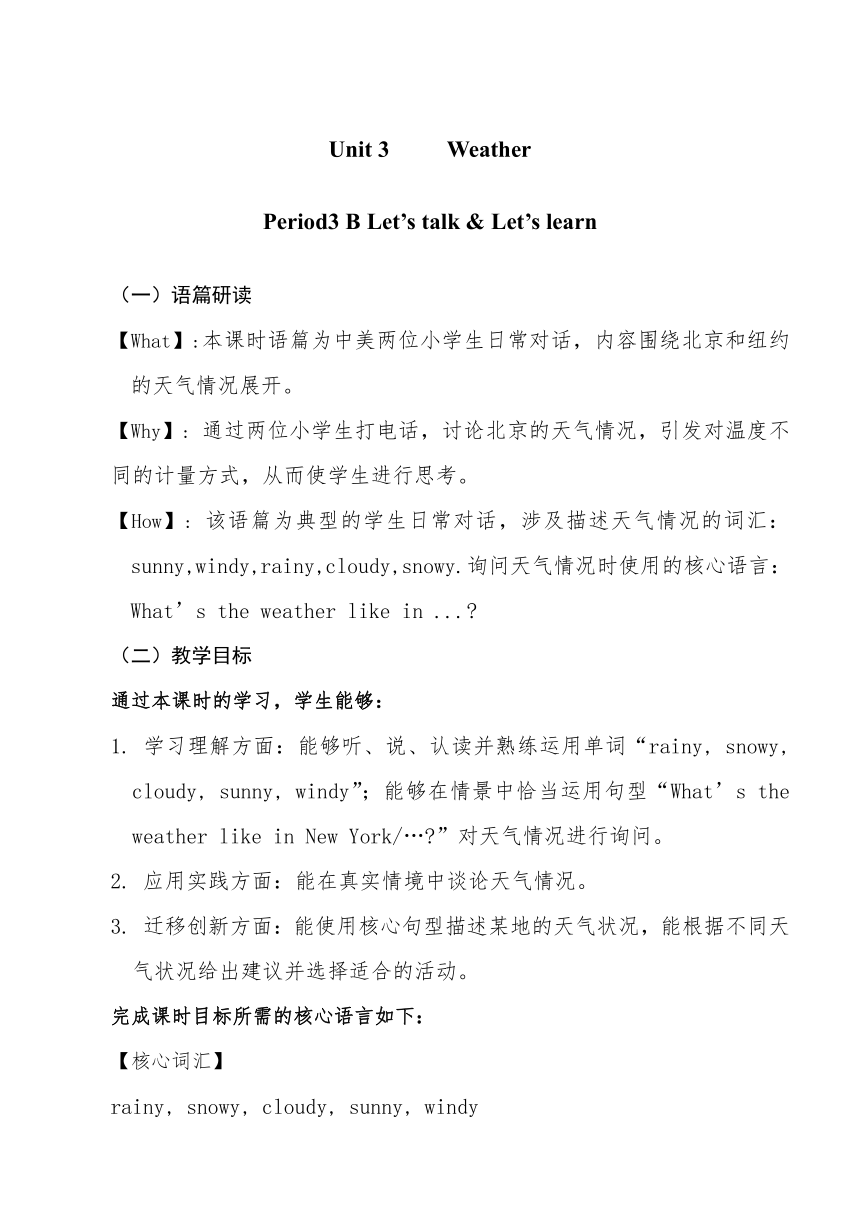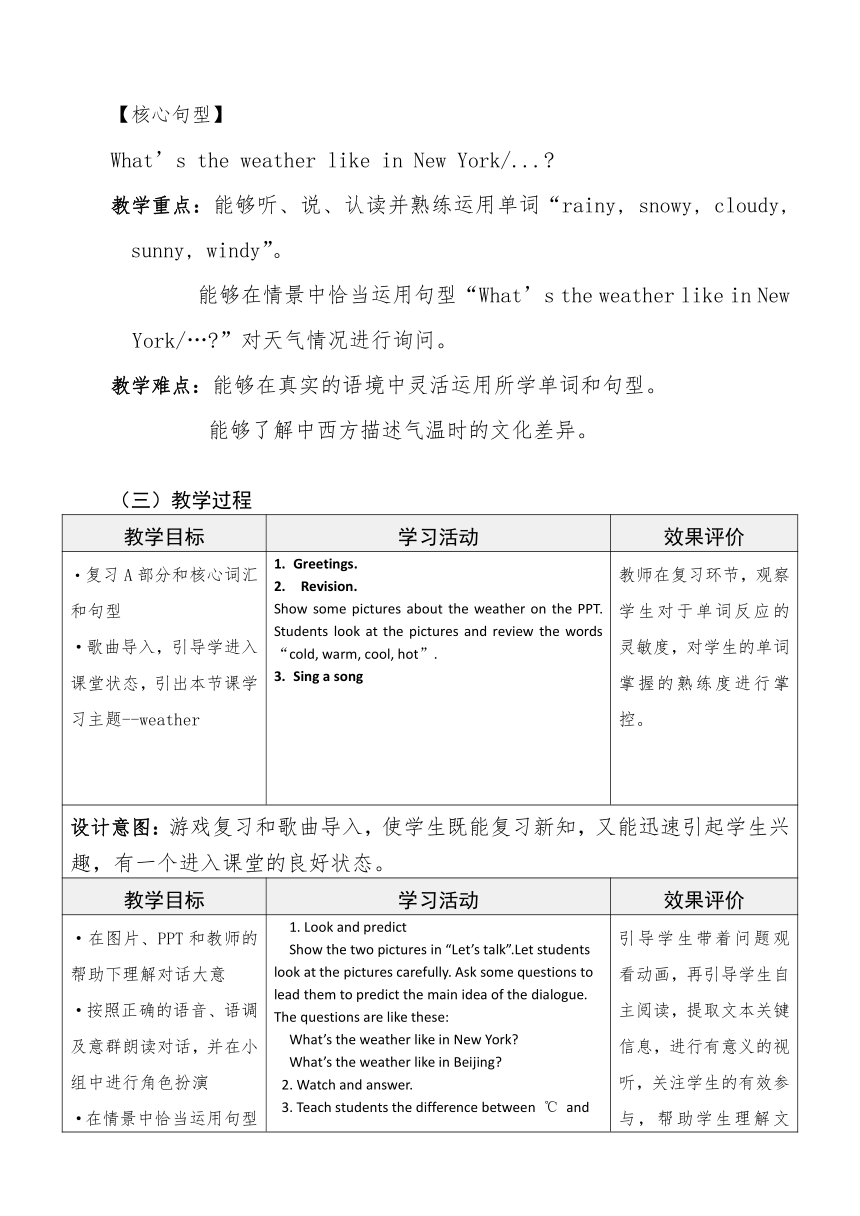Unit 3 Weather Period 3 Part B Let’s talk & Let’s learn表格式教案
文档属性
| 名称 | Unit 3 Weather Period 3 Part B Let’s talk & Let’s learn表格式教案 |  | |
| 格式 | docx | ||
| 文件大小 | 1.7MB | ||
| 资源类型 | 教案 | ||
| 版本资源 | 人教版(PEP) | ||
| 科目 | 英语 | ||
| 更新时间 | 2024-03-23 20:17:49 | ||
图片预览



文档简介
Unit 3 Weather
Period3 B Let’s talk & Let’s learn
(一)语篇研读
【What】:本课时语篇为中美两位小学生日常对话,内容围绕北京和纽约的天气情况展开。
【Why】: 通过两位小学生打电话,讨论北京的天气情况,引发对温度不同的计量方式,从而使学生进行思考。
【How】: 该语篇为典型的学生日常对话,涉及描述天气情况的词汇:sunny,windy,rainy,cloudy,snowy.询问天气情况时使用的核心语言:What’s the weather like in ...
(二)教学目标
通过本课时的学习,学生能够:
1. 学习理解方面:能够听、说、认读并熟练运用单词“rainy, snowy, cloudy, sunny, windy”;能够在情景中恰当运用句型“What’s the weather like in New York/… ”对天气情况进行询问。
2. 应用实践方面:能在真实情境中谈论天气情况。
3. 迁移创新方面:能使用核心句型描述某地的天气状况,能根据不同天气状况给出建议并选择适合的活动。
完成课时目标所需的核心语言如下:
【核心词汇】
rainy, snowy, cloudy, sunny, windy
【核心句型】
What’s the weather like in New York/...
教学重点:能够听、说、认读并熟练运用单词“rainy, snowy, cloudy, sunny, windy”。
能够在情景中恰当运用句型“What’s the weather like in New York/… ”对天气情况进行询问。
教学难点:能够在真实的语境中灵活运用所学单词和句型。
能够了解中西方描述气温时的文化差异。
(三)教学过程
教学目标 学习活动 效果评价
·复习A部分和核心词汇和句型 ·歌曲导入,引导学进入课堂状态,引出本节课学习主题--weather Greetings. Revision. Show some pictures about the weather on the PPT. Students look at the pictures and review the words “cold, warm, cool, hot”. Sing a song 教师在复习环节,观察学生对于单词反应的灵敏度,对学生的单词掌握的熟练度进行掌控。
设计意图:游戏复习和歌曲导入,使学生既能复习新知,又能迅速引起学生兴趣,有一个进入课堂的良好状态。
教学目标 学习活动 效果评价
·在图片、PPT和教师的帮助下理解对话大意 ·按照正确的语音、语调及意群朗读对话,并在小组中进行角色扮演 ·在情景中恰当运用句型“What’s the weather like in New York/… ”对天气情况进行询问 ·在语境中理解新词“rainy”和“degrees”的意思并能正确发音 1. Look and predict Show the two pictures in “Let’s talk”.Let students look at the pictures carefully. Ask some questions to lead them to predict the main idea of the dialogue. The questions are like these: What’s the weather like in New York What’s the weather like in Beijing 2. Watch and answer. 3. Teach students the difference between ℃ and℉. Check the answers and teach the new words and the new sentences. Write down the word “degree” and the unit “℃” on the blackboard. Help students understand the word “degree”. Lead students to look at the picture of the thermometer. Focus on the units “℃” and “℉”.Use the PPT to help students understand the differences between the units “℃”and“℉”. 5. Get the overall perception of the dialogue. Watch the cartoon again. Perceive the contextual meaning and check the answers of the chart. 6.Listen and imitate. 7. Act out 引导学生带着问题观看动画,再引导学生自主阅读,提取文本关键信息,进行有意义的视听,关注学生的有效参与,帮助学生理解文本。 让学生再次观看动画,进一步感知整个对话的语境,并在语境中进一步理解对话。
设计意图:呈现单词词性变化时,引导学生发现与总结规律,培养学生学习自主性和探索驱力。自编和创设对话让学生在语境中练习和运用语言。
教学目标 学习活动 效果评价
·利听、说、认读单词“rainy, snowy, cloudy, sunny, windy” ·在语境中正确运用这五个单词描述天气状况 ·在语境中理解“world, Sydney, London, Moscow, Singapore”的意思并能够正确发音 ·熟练地用句型“—What’s the weather like in Sydney —It’s hot and sunny.”询问或描述天气情况 Look and say Show students a picture about weather report, then play the audio about it. Lead students to answer the basic questions about the topic: “What’s the weather like in ... ”. Point to the cities and let students read it one by one for several times. Teach the word ”sunny”. Play the recording. Students listen and try to answer with “It’s hot and sunny.”Write down the sentence structure “What’s the weather like in… ” and the word “sunny” on the blackboard. Write the letter “-y” in red chalk. Show the word card to students. Ask students learn to read the word. Point to the map and ask. Ask students practice the word like this: Sunny, sunny. It’s sunny in Sydney. Learn the word “rainy”, “snowy”, “windy”, and “cloudy”. Then lead students to summarize how make the nouns turn to adjectives. Listen, read and practice. (1) Students read the words and the sentences after the recording. Pay attention to the pronunciation and the intonation. (2) Students use the sentence structures “—What’s the weather like in… —It’s…” to practice in pairs. Deepen students’ understanding of the new words. 3.Practice 1. Role play the conversation. 2. To be a weather reporter. In this period, make students to create a new conversation. 4. Consolidation and Extension 1.Let’s play Use the words and sentences to make up a new dialogue. 2. Value education. 教师在学生任务完成的过程中,及时关注到不同层次的学生,并且在任务完成后,学生在进行输出时,要有效兼顾到不同学情的学生。 输出环节,要注意兼顾到不同层次的学生,使学生能够整体的迁移。 总结与归纳时,要注意观察学生的回答情况,对于基础一般的学生要及时给予关注。
设计意图:通过设置疑问,引导学生发现文本难点,辅助图片,使学生直观的观察和发现,从而进行探索。
板书设计
教学反思
1. 整个教学设计从课堂的导入,到知识的输入,直到最后的整合运用,都经过层层铺垫,有着很清晰的层次感和很强的逻辑性。 2. 注重学生读的能力的培养,始终利用多媒体进行示范教学,引导学生模仿正确的语音和语调。 3. 利用说唱歌谣的形式来调动学生的学习积极性,而且只给出了范例,让学生学会举一反三,给学生时间和空间来充分展现自己,提高了学生的课堂参与度和学习积极性。 4. 利用一切契机帮助学生运用句型,在句型中学习,在句型中练习,在句型中运用。 5. 重视学生对文本的理解,以问题为导向引导学生学习,帮助学生在回答问题的过程中逐步理解文本,并利用表格帮助学生梳理文本信息。 6. 通过教材图片和PPT,帮助学生理解中西方气温描述中的文化差异,了解华氏温度及摄氏温度的概念。 7. 通过创设情景帮助学生了解世界主要城市的国旗及讨论其天气状况,并学会描述这些城市的天气状况。
表现性任务及评价量规 (包括本课时涉及到的所有表现性评价任务)
任务一:
(1)任务目标:
1.能够听、说、认读并熟练运用单词“rainy, snowy, cloudy, sunny, windy”。
2.能够在情景中恰当运用句型“What’s the weather like in New York/… ”对天气情况进行询问。
3.能够在真实的语境中灵活运用所学单词和句型。
4.能够了解中西方描述气温时的文化差异。
(2)任务描述:
1.培养学生勤于观察,善于思考,积极表达的英语行为习惯。
2.在语境语篇中让学生通过互问互答,情景表演,创编对话等方式培养其自信表达观点的英语素养。
(3)评价标准:
A(90-100) B(70-80) C (70以下) 个人评价
朗读 能熟练认读所学单词及对话 能够较熟练朗读单词及对话 经过别人指导可朗读出来
配音 能够熟练进行配音 能够比较熟练进行配音 经过别人提醒或指导可以进行配音
表演 能够熟练的加入动作表演本节所学 能够比较熟练的表演本节所学 经过别人提醒或指导能够表演
我这样评价自己:
五、单元教学反思(反思可以从活动设计、教材处理、时间安排、学生参与度、教学评一致性、学生学习深度、学习支持等方面进行)该板块各学校授课后自行撰写。
Period3 B Let’s talk & Let’s learn
(一)语篇研读
【What】:本课时语篇为中美两位小学生日常对话,内容围绕北京和纽约的天气情况展开。
【Why】: 通过两位小学生打电话,讨论北京的天气情况,引发对温度不同的计量方式,从而使学生进行思考。
【How】: 该语篇为典型的学生日常对话,涉及描述天气情况的词汇:sunny,windy,rainy,cloudy,snowy.询问天气情况时使用的核心语言:What’s the weather like in ...
(二)教学目标
通过本课时的学习,学生能够:
1. 学习理解方面:能够听、说、认读并熟练运用单词“rainy, snowy, cloudy, sunny, windy”;能够在情景中恰当运用句型“What’s the weather like in New York/… ”对天气情况进行询问。
2. 应用实践方面:能在真实情境中谈论天气情况。
3. 迁移创新方面:能使用核心句型描述某地的天气状况,能根据不同天气状况给出建议并选择适合的活动。
完成课时目标所需的核心语言如下:
【核心词汇】
rainy, snowy, cloudy, sunny, windy
【核心句型】
What’s the weather like in New York/...
教学重点:能够听、说、认读并熟练运用单词“rainy, snowy, cloudy, sunny, windy”。
能够在情景中恰当运用句型“What’s the weather like in New York/… ”对天气情况进行询问。
教学难点:能够在真实的语境中灵活运用所学单词和句型。
能够了解中西方描述气温时的文化差异。
(三)教学过程
教学目标 学习活动 效果评价
·复习A部分和核心词汇和句型 ·歌曲导入,引导学进入课堂状态,引出本节课学习主题--weather Greetings. Revision. Show some pictures about the weather on the PPT. Students look at the pictures and review the words “cold, warm, cool, hot”. Sing a song 教师在复习环节,观察学生对于单词反应的灵敏度,对学生的单词掌握的熟练度进行掌控。
设计意图:游戏复习和歌曲导入,使学生既能复习新知,又能迅速引起学生兴趣,有一个进入课堂的良好状态。
教学目标 学习活动 效果评价
·在图片、PPT和教师的帮助下理解对话大意 ·按照正确的语音、语调及意群朗读对话,并在小组中进行角色扮演 ·在情景中恰当运用句型“What’s the weather like in New York/… ”对天气情况进行询问 ·在语境中理解新词“rainy”和“degrees”的意思并能正确发音 1. Look and predict Show the two pictures in “Let’s talk”.Let students look at the pictures carefully. Ask some questions to lead them to predict the main idea of the dialogue. The questions are like these: What’s the weather like in New York What’s the weather like in Beijing 2. Watch and answer. 3. Teach students the difference between ℃ and℉. Check the answers and teach the new words and the new sentences. Write down the word “degree” and the unit “℃” on the blackboard. Help students understand the word “degree”. Lead students to look at the picture of the thermometer. Focus on the units “℃” and “℉”.Use the PPT to help students understand the differences between the units “℃”and“℉”. 5. Get the overall perception of the dialogue. Watch the cartoon again. Perceive the contextual meaning and check the answers of the chart. 6.Listen and imitate. 7. Act out 引导学生带着问题观看动画,再引导学生自主阅读,提取文本关键信息,进行有意义的视听,关注学生的有效参与,帮助学生理解文本。 让学生再次观看动画,进一步感知整个对话的语境,并在语境中进一步理解对话。
设计意图:呈现单词词性变化时,引导学生发现与总结规律,培养学生学习自主性和探索驱力。自编和创设对话让学生在语境中练习和运用语言。
教学目标 学习活动 效果评价
·利听、说、认读单词“rainy, snowy, cloudy, sunny, windy” ·在语境中正确运用这五个单词描述天气状况 ·在语境中理解“world, Sydney, London, Moscow, Singapore”的意思并能够正确发音 ·熟练地用句型“—What’s the weather like in Sydney —It’s hot and sunny.”询问或描述天气情况 Look and say Show students a picture about weather report, then play the audio about it. Lead students to answer the basic questions about the topic: “What’s the weather like in ... ”. Point to the cities and let students read it one by one for several times. Teach the word ”sunny”. Play the recording. Students listen and try to answer with “It’s hot and sunny.”Write down the sentence structure “What’s the weather like in… ” and the word “sunny” on the blackboard. Write the letter “-y” in red chalk. Show the word card to students. Ask students learn to read the word. Point to the map and ask. Ask students practice the word like this: Sunny, sunny. It’s sunny in Sydney. Learn the word “rainy”, “snowy”, “windy”, and “cloudy”. Then lead students to summarize how make the nouns turn to adjectives. Listen, read and practice. (1) Students read the words and the sentences after the recording. Pay attention to the pronunciation and the intonation. (2) Students use the sentence structures “—What’s the weather like in… —It’s…” to practice in pairs. Deepen students’ understanding of the new words. 3.Practice 1. Role play the conversation. 2. To be a weather reporter. In this period, make students to create a new conversation. 4. Consolidation and Extension 1.Let’s play Use the words and sentences to make up a new dialogue. 2. Value education. 教师在学生任务完成的过程中,及时关注到不同层次的学生,并且在任务完成后,学生在进行输出时,要有效兼顾到不同学情的学生。 输出环节,要注意兼顾到不同层次的学生,使学生能够整体的迁移。 总结与归纳时,要注意观察学生的回答情况,对于基础一般的学生要及时给予关注。
设计意图:通过设置疑问,引导学生发现文本难点,辅助图片,使学生直观的观察和发现,从而进行探索。
板书设计
教学反思
1. 整个教学设计从课堂的导入,到知识的输入,直到最后的整合运用,都经过层层铺垫,有着很清晰的层次感和很强的逻辑性。 2. 注重学生读的能力的培养,始终利用多媒体进行示范教学,引导学生模仿正确的语音和语调。 3. 利用说唱歌谣的形式来调动学生的学习积极性,而且只给出了范例,让学生学会举一反三,给学生时间和空间来充分展现自己,提高了学生的课堂参与度和学习积极性。 4. 利用一切契机帮助学生运用句型,在句型中学习,在句型中练习,在句型中运用。 5. 重视学生对文本的理解,以问题为导向引导学生学习,帮助学生在回答问题的过程中逐步理解文本,并利用表格帮助学生梳理文本信息。 6. 通过教材图片和PPT,帮助学生理解中西方气温描述中的文化差异,了解华氏温度及摄氏温度的概念。 7. 通过创设情景帮助学生了解世界主要城市的国旗及讨论其天气状况,并学会描述这些城市的天气状况。
表现性任务及评价量规 (包括本课时涉及到的所有表现性评价任务)
任务一:
(1)任务目标:
1.能够听、说、认读并熟练运用单词“rainy, snowy, cloudy, sunny, windy”。
2.能够在情景中恰当运用句型“What’s the weather like in New York/… ”对天气情况进行询问。
3.能够在真实的语境中灵活运用所学单词和句型。
4.能够了解中西方描述气温时的文化差异。
(2)任务描述:
1.培养学生勤于观察,善于思考,积极表达的英语行为习惯。
2.在语境语篇中让学生通过互问互答,情景表演,创编对话等方式培养其自信表达观点的英语素养。
(3)评价标准:
A(90-100) B(70-80) C (70以下) 个人评价
朗读 能熟练认读所学单词及对话 能够较熟练朗读单词及对话 经过别人指导可朗读出来
配音 能够熟练进行配音 能够比较熟练进行配音 经过别人提醒或指导可以进行配音
表演 能够熟练的加入动作表演本节所学 能够比较熟练的表演本节所学 经过别人提醒或指导能够表演
我这样评价自己:
五、单元教学反思(反思可以从活动设计、教材处理、时间安排、学生参与度、教学评一致性、学生学习深度、学习支持等方面进行)该板块各学校授课后自行撰写。
